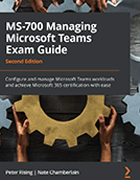Prepare for Teams admin certification with MS-700 study guide
Learn the administrative responsibilities for the Teams phone system in this excerpt from 'MS-700 Managing Microsoft Teams Exam Guide.'
With more organizations adopting Microsoft Teams to support day-to-day communication and collaboration, it's key for IT professionals to be able to effectively manage and administer a Teams deployment.
IT professionals seeking certification as a Teams Administrator Associate must pass the MS-700: Managing Microsoft Teams exam. Exam candidates are responsible for configuring and managing teams, channels, apps, calling, meetings and chats, as well as managing Teams phone services and the operation of Teams clients and devices.
The MS-700 exam tests the following technical tasks:
- Configuring and managing a Teams environment.
- Managing teams, channels, apps and chat.
- Managing meetings and calling.
- Monitoring, reporting and troubleshooting Teams.
In reading MS-700 Managing Microsoft Teams Exam Guide by Peter Rising and Nate Chamberlain, IT professionals can review Teams administrator responsibilities, including network management, security and compliance, configuration and management of Teams devices, management of collaboration experiences and phone system management.
The MS-700 study guide includes practice questions at the end of each chapter, as well as a mock exam. Each chapter also includes links to the relevant Microsoft documentation for further study.
Below is an excerpt from Chapter 13, "Managing Phone System for Microsoft Teams," where readers review managing phone system capabilities, user voice settings, dial plans and resource accounts. The chapter also reviews using the health dashboard for Direct Routing to identify potential issues.
Explore MS-700 Managing Microsoft Teams Exam Guide
Click here to read Chapter 13, "Managing Phone System for Microsoft Teams."





